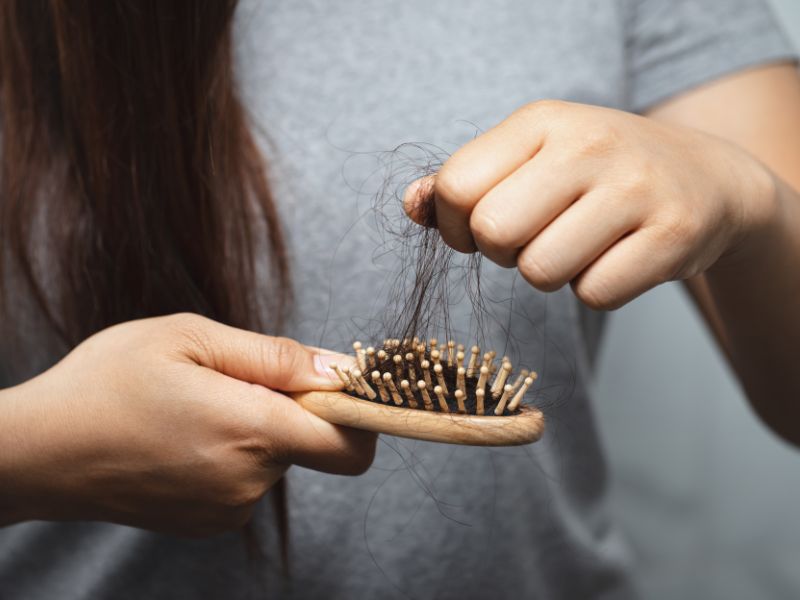Hair changes are a natural part of life, but one of the most common concerns people face is noticing strands on their pillow, in the shower, or caught in their brush. This often raises the question of whether the hair is simply going through a normal shedding phase or if it is a sign of something more serious, like hair loss. Understanding the difference between the two is important because it helps determine whether you should adjust your routine, make lifestyle changes, or seek professional advice.
Hair shedding is a normal part of the growth cycle, but hair loss signals a disruption that can be temporary or long-term, depending on the underlying cause. While both may look similar at first glance, their root causes, patterns, and long-term effects differ significantly. By learning how to distinguish normal shedding from true hair loss, you can take the right steps to protect your scalp and encourage healthier growth.

Understanding the Hair Growth Cycle
To fully grasp the difference between hair shedding and hair loss, it helps to first understand the natural growth cycle of hair. Each strand goes through several stages, and shedding is actually a healthy sign that your scalp is renewing itself. However, disruptions in this cycle can cause excessive shedding or premature loss, which may require more focused care.
Key phases of the hair growth cycle include:
-
Anagen phase: The active growth stage that can last several years, where most of your hair is firmly anchored and continuously growing.
-
Catagen phase: A short transitional stage, typically lasting a few weeks, where hair growth slows and follicles begin to shrink.
-
Telogen phase: The resting stage lasting around three months, where older hairs remain in the follicle until they are naturally released.
-
Exogen phase: The shedding stage, when old hairs fall out to make room for new strands entering the anagen phase.
Recognizing this cycle helps you understand why shedding a certain amount of hair daily is normal. Problems arise when the balance is disrupted and more strands leave the resting stage than new ones entering growth, leading to noticeable thinning or loss. By monitoring changes in your hair cycle, you can better identify whether what you are experiencing is routine shedding or something that requires deeper attention.

Key Differences Between Hair Shedding and Hair Loss
While both involve losing hair strands, hair shedding and hair loss are not the same condition, and understanding the differences is essential for proper care and treatment. Shedding is usually temporary and linked to the natural growth cycle, while hair loss often indicates an underlying issue that disrupts growth altogether.
Here are the main differences:
-
Cause: Hair shedding is typically triggered by temporary factors such as stress, illness, or seasonal changes, while hair loss often results from genetics, hormonal imbalances, or medical conditions.
-
Duration: Shedding usually balances out within a few months as new hair grows back, whereas hair loss often persists without regrowth unless addressed with treatment.
-
Appearance: Shedding tends to spread evenly across the scalp without visible thinning, while hair loss often creates noticeable bald spots, receding hairlines, or widening parts.
-
Hair regrowth: With shedding, new hair sprouts normally from the follicles, but with hair loss, follicles may shrink or stop producing hair altogether.
-
Volume impact: Regular shedding does not significantly alter hair thickness, but hair loss leads to a gradual or sudden decrease in overall density.
Recognizing these distinctions helps you determine whether you are experiencing a natural cycle or a more serious issue that requires professional attention. Knowing the signs empowers you to take timely action to maintain both the health and fullness of your hair.

How to Manage Excessive Hair Shedding
Experiencing more shedding than usual can be concerning, but in many cases, it is possible to reduce the amount of hair fall by making adjustments to your daily habits and haircare routine. Excessive shedding often points to temporary triggers, and with proper management, hair can return to its normal growth cycle.
Here are some practical ways to manage excessive hair shedding:
-
Maintain a balanced diet: Eating foods rich in vitamins, minerals, and proteins supports strong hair follicles and encourages healthy regrowth.
-
Reduce stress levels: High stress can push more hair into the shedding phase, so practices like meditation, exercise, or mindful breathing may help.
-
Be gentle with styling: Minimize the use of tight hairstyles, heat styling tools, and chemical treatments, as these can put added strain on your strands.
-
Avoid overwashing: Washing hair too often can strip natural oils, so adjust your routine based on your hair type to prevent unnecessary dryness and breakage.
-
Use strengthening shampoos and conditioners: Products designed to nourish the scalp and fortify strands can help reduce shedding caused by weakness.
-
Check medications and health factors: Some medications and health conditions contribute to shedding, so consulting with a healthcare provider may provide clarity.
-
Consider scalp massages: Stimulating the scalp can improve circulation and encourage the hair growth cycle to return to balance.
While some shedding is completely natural, paying attention to your habits and overall health can significantly lessen the impact of excessive shedding. By taking proactive steps, you can support stronger, more resilient hair and ease the worry of temporary hair fall.

Preventing and Treating Hair Loss
Unlike normal shedding, hair loss is often progressive and requires more deliberate strategies to manage effectively. Preventing and treating hair loss involves understanding the underlying causes, supporting scalp health, and adopting consistent habits that strengthen hair from the roots. While not all cases of hair loss can be fully reversed, many approaches can slow its progression and even encourage regrowth when addressed early.
Here are effective ways to prevent and treat hair loss:
-
Maintain scalp health: A clean and nourished scalp is essential for healthy follicles, so using gentle cleansers and avoiding buildup is an important first step.
-
Incorporate hair-friendly nutrients: Vitamins such as biotin, vitamin D, zinc, and iron play a vital role in strengthening hair and preventing thinning.
-
Limit harsh treatments: Excessive coloring, bleaching, or chemical straightening weakens hair strands and accelerates loss, so moderation is key.
-
Choose sulfate-free and nourishing products: Choosing products free of harsh ingredients helps preserve scalp balance and reduces irritation that can worsen hair loss.
-
Practice protective styling: Low-tension hairstyles that reduce strain on the roots prevent traction alopecia and long-term follicle damage.
-
Seek medical treatments when needed: Options like topical minoxidil, oral medications, or professional therapies may be recommended for persistent hair loss.
-
Consider natural remedies: Oils such as rosemary, castor, or peppermint oil may help stimulate circulation and support healthier hair growth.
-
Address hormonal or medical causes: Since conditions like thyroid imbalance or PCOS can trigger hair loss, consulting a healthcare provider ensures the right treatment plan.
Addressing hair loss requires both preventive care and, when necessary, professional guidance. By combining consistent at-home practices with expert solutions, you can protect your hair’s long-term health and improve its strength, fullness, and resilience.

Lifestyle Habits for Stronger, Healthier Hair
The health of your hair is closely tied to your overall lifestyle choices. While products and treatments play a role, daily habits often have the greatest long-term impact on the strength, shine, and resilience of your strands. Building a healthy lifestyle not only benefits your body but also directly supports your scalp and hair growth cycle. Small, consistent changes can make a noticeable difference in preventing thinning, reducing breakage, and promoting vibrant, healthy hair.
Here are key lifestyle habits that support stronger, healthier hair:
-
Balanced nutrition: A diet rich in lean proteins, leafy greens, nuts, seeds, and omega-3 fatty acids provides essential nutrients that fuel hair growth and repair.
-
Stay hydrated: Drinking enough water daily helps maintain proper scalp moisture and prevents dry, brittle strands prone to breakage.
-
Regular exercise: Physical activity improves blood circulation, ensuring that hair follicles receive adequate oxygen and nutrients for healthy growth.
-
Adequate sleep: Quality rest allows the body to repair and regenerate, which includes supporting stronger hair growth and reducing stress-related shedding.
-
Stress management: Incorporating relaxation techniques such as meditation, yoga, or breathing exercises can prevent stress-induced hair loss.
-
Limit smoking and alcohol: Both habits can restrict blood flow to the scalp and reduce nutrient absorption, negatively affecting hair health.
-
Protect from environmental damage: Wearing a hat in strong sunlight or protecting your hair from pollution helps prevent long-term damage and weakening of strands.
-
Consistent hair care routine: Gentle detangling, protective styling, and regular trims ensure hair remains strong and resilient over time.
Adopting these healthy lifestyle habits creates a solid foundation for hair that looks and feels its best. When combined with proper hair care practices and nourishing products, these choices allow your hair to thrive naturally.
Caring for your hair goes far beyond external treatments, as daily lifestyle habits play a central role in determining its long-term health and vitality. By focusing on balanced nutrition, proper hydration, exercise, rest, and mindful stress management, you can strengthen your strands from within and reduce risks of breakage, thinning, and loss. Protecting your hair from environmental factors and maintaining a consistent haircare routine ensures your efforts translate into lasting results. Contact us today to learn more. We offer hair care products designed to support your journey to stronger, healthier hair at Kpure.


